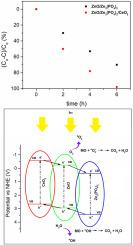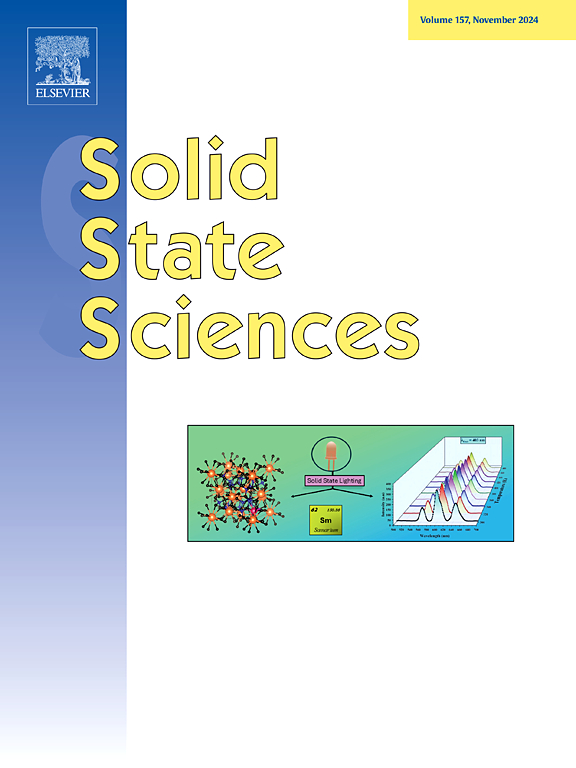等离子电解氧化法在锌上形成 ZnO/Zn3(PO4)2/CeO2 光催化剂
IF 3.4
3区 化学
Q2 CHEMISTRY, INORGANIC & NUCLEAR
引用次数: 0
摘要
通过在磷酸盐碱性电解液(PAE)中对锌进行等离子电解氧化,在 CeO2 颗粒浓度高达 1.5 g/L 的情况下,制备出了掺杂有 CeO2 颗粒的 ZnO/Zn3(PO4)2 涂层,用于光催化降解甲基橙(MO)。ZnO/Zn3(PO4)2 涂层中的 CeO2 颗粒含量由 PAE 中 CeO2 颗粒的浓度决定。对涂层的形态、化学成分和相组成以及光收集特性进行了广泛的研究。ZnO/Zn3(PO4)2/CeO2 涂层的光催化活性(PA)高于 ZnO/Zn3(PO4)2。ZnO/Zn3(PO4)2/CeO2 涂层的 PA 与 PAE 中 CeO2 颗粒的含量密切相关,在 PAE 中加入 0.75 g/L 的 CeO2 颗粒形成的 ZnO/Zn3(PO4)2/CeO2 涂层的 PA 最高。与 ZnO/Zn3(PO4)2 相比,ZnO/Zn3(PO4)2/CeO2 的 PA 较高,这是因为光生电子/空穴重组较低。MO 的光催化降解遵循伪一阶动力学模型,与 ZnO/Zn3(PO4)2 涂层相比,光活性最强的 ZnO/Zn3(PO4)2/CeO2 涂层的反应常数增加了约两倍。辐照 6 小时后,ZnO/Zn3(PO4)2 和光催化活性最高的 ZnO/Zn3(PO4)2/CeO2 的 PA 分别为 70% 和 98%。此外,还提出了 ZnO/Zn3(PO4)2/CeO2 光催化剂光降解 MO 的机理。本文章由计算机程序翻译,如有差异,请以英文原文为准。

ZnO/Zn3(PO4)2/CeO2 photocatalysts formed on zinc by plasma electrolytic oxidation
ZnO/Zn3(PO4)2 coatings doped with CeO2 particles for use in photocatalytic degradation of methyl orange (MO) were created by plasma electrolytic oxidation of zinc in a phosphate alkaline electrolyte (PAE) with CeO2 particle concentrations of up to 1.5 g/L. The CeO2 particle content in ZnO/Zn3(PO4)2 coatings was determined by the concentration of CeO2 particles in the PAE. Extensive research was conducted on coating morphology, chemical and phase compositions, and light-harvesting properties. The photocatalytic activity (PA) of ZnO/Zn3(PO4)2/CeO2 coatings was higher than ZnO/Zn3(PO4)2. The PA of ZnO/Zn3(PO4)2/CeO2 coatings strongly depends on the amount of CeO2 particles in PAE, and the highest PA was observed for ZnO/Zn3(PO4)2/CeO2 coating formed in PAE by adding 0.75 g/L of CeO2 particles. The higher PA of ZnO/Zn3(PO4)2/CeO2 compared to ZnO/Zn3(PO4)2 is due to a lower photogenerated electron/hole recombination. The photocatalytic degradation of MO followed a pseudo-first order kinetic model and the reaction constant of the most photoactive ZnO/Zn3(PO4)2/CeO2 coating was increased about twofold compared to the ZnO/Zn3(PO4)2 coating. After 6 h of irradiation, the PA for ZnO/Zn3(PO4)2 and the most photocatalytically active ZnO/Zn3(PO4)2/CeO2 was about 70 % and 98 %, respectively. A mechanism for the photodegradation of MO with the ZnO/Zn3(PO4)2/CeO2 photocatalyst was also proposed.
求助全文
通过发布文献求助,成功后即可免费获取论文全文。
去求助
来源期刊

Solid State Sciences
化学-无机化学与核化学
CiteScore
6.60
自引率
2.90%
发文量
214
审稿时长
27 days
期刊介绍:
Solid State Sciences is the journal for researchers from the broad solid state chemistry and physics community. It publishes key articles on all aspects of solid state synthesis, structure-property relationships, theory and functionalities, in relation with experiments.
Key topics for stand-alone papers and special issues:
-Novel ways of synthesis, inorganic functional materials, including porous and glassy materials, hybrid organic-inorganic compounds and nanomaterials
-Physical properties, emphasizing but not limited to the electrical, magnetical and optical features
-Materials related to information technology and energy and environmental sciences.
The journal publishes feature articles from experts in the field upon invitation.
Solid State Sciences - your gateway to energy-related materials.
 求助内容:
求助内容: 应助结果提醒方式:
应助结果提醒方式:


